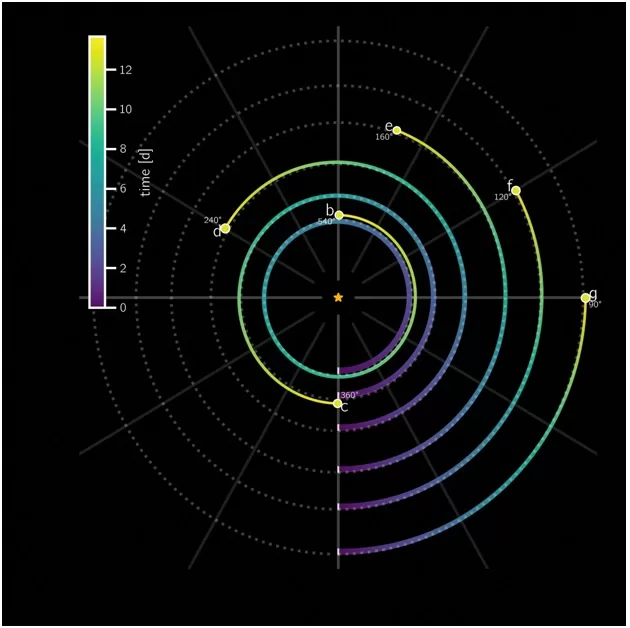Science & Environment
Discovery of Six Synchronized Planets Offers Potential Breakthrough in Cosmic Enigma

Highlights
- Astronomers unveil the discovery of six Synchronized Planets (sub-Neptune planets) exhibiting synchronized orbits around a star located 100 light-years from Earth.
- These planets, with diameters two to three times that of Earth but smaller than Neptune, orbit closely to their stars, showcasing a unique cosmic phenomenon.
- The presence of orbital resonance indicates that the synchronized orbits of these sub-Neptunes have endured for approximately 4 billion years, hinting at a stable celestial arrangement.
- Sub-Neptunes, prevalent in the Milky Way galaxy but notably absent from our solar system, pose a fundamental scientific puzzle that researchers aim to decipher.
- Ongoing research focuses on exploring the composition of sub-Neptunes, examining various combinations of rock, water, and atmospheric elements to understand their bulk properties.
- Meticulous observations of slight brightness dips during the planets’ transits in front of their host star, HD110067, highlight the effectiveness of current observational methods.
- Despite falling outside the traditional habitable zone, the varied orbital range of these sub-Neptunes prompts reconsideration of habitability considerations, influenced by their atmospheres.
- Researchers express optimism about the operational James Webb Space Telescope (JWST), anticipating its pivotal role in providing insights into sub-Neptunes’ composition, potential habitability, and broader cosmic understanding.
- The synchronized sub-Neptune discovery offers a captivating glimpse into the intricate orbital dynamics of planets beyond our solar system, contributing to the ongoing expansion of our cosmic knowledge.
In a groundbreaking discovery, astronomers have unveiled a cosmic puzzle involving six sub-Neptune planets found in synchronized orbits around a star located approximately 100 light-years from Earth. These sub-Neptunes, characterized by diameters two to three times that of Earth but smaller than Neptune, orbit closer to their stars than Mercury does to the sun.
The findings, published in the journal Nature and led by researchers from the University of Bern in Switzerland and the University of Chicago, reveal these planets to be in a rare condition known as orbital resonance. Intriguingly, their synchronized orbits around the star have apparently remained unchanged since their formation around 4 billion years ago, indicating a lack of chaotic events like giant impact events perturbing their orbits.
Astronomer Hugh Osborn emphasizes the mathematical beauty of this resonance aspect, highlighting the system’s potential to unlock the secrets of these mysterious sub-Neptune planets. Unlike Earth-like planets, sub-Neptunes have proven enigmatic, with their fundamental nature eluding scientists.
Despite their prevalence in our Milky Way galaxy, with hundreds discovered so far, the composition of sub-Neptunes remains a subject of active research. Rafael Luque, lead author of the study and a University of Chicago astronomer, explains that various combinations of rock, water, and atmospheric compositions could replicate their bulk properties.
The newly discovered sub-Neptunes, ranging from 1.9 to 2.9 times Earth’s diameter, exhibit large atmospheres. Positioned around 100 light-years away in the northern constellation Coma Berenices, these planets and their host star, HD110067, were detected through observations of slight dips in the star’s brightness as they crossed in front of it.
One of the intriguing aspects is the orbital range of these planets around their star, varying between 6% and 20% of the distance between Earth and the sun. Although not residing within the traditional habitable zone for terrestrial planets, the definition of habitability for sub-Neptunes may differ due to their atmospheres, which could influence surface temperatures regardless of proximity to their star.
The researchers are optimistic that the James Webb Space Telescope (JWST), operational since last year, will play a pivotal role in unraveling the mysteries surrounding these sub-Neptunes. The telescope’s capabilities are expected to shed light on their potential habitability and provide valuable insights into the broader understanding of these fascinating celestial bodies. As the quest for cosmic knowledge continues, these synchronized sub-Neptunes offer a glimpse into the intricate dance of planets beyond our solar system.


















































